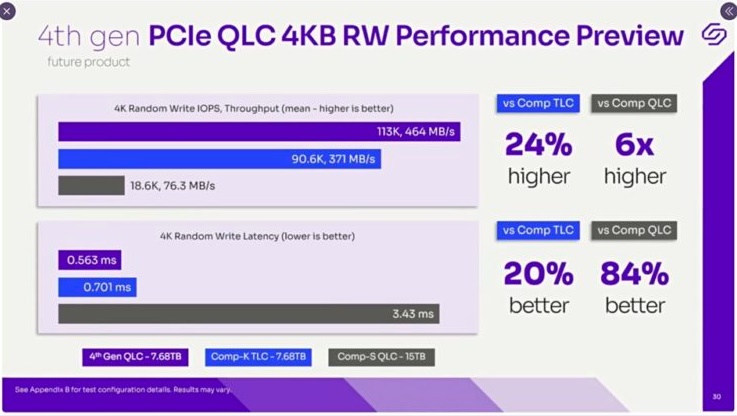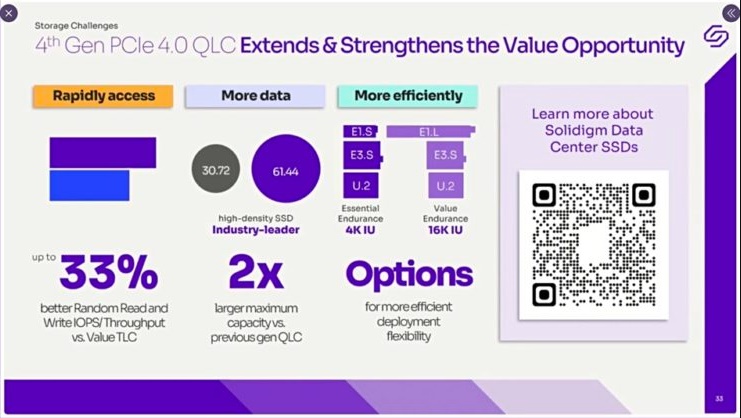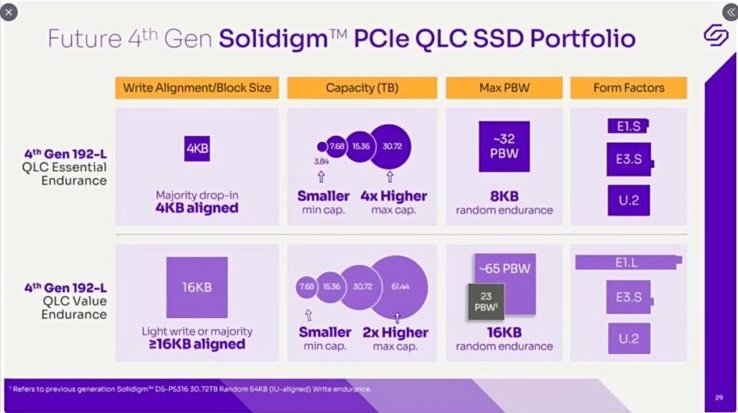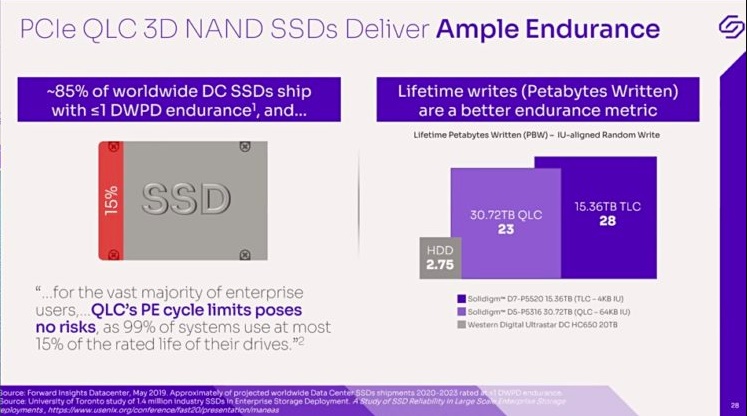Solidigm's 61 TB SSD Hopes to Vanquish HDDs
Flexing NAND muscles in a decreasingly HDD-focused storage world.
Solidigm is looking to one-up even the densest mechanical drives with its upcoming SSD products, and the race isn't even close. The company plans to introduce 30 TB and 61 TB capacity SSDs based on the company's 192-layer QLC (quad-Level Cell) technology. Hidden between the company's roadmap for its Tech Field Day 2022 event, Solidigm's push showcases the breakneck speed of SSD capacity and throughput improvements that are a significant reason for HDD's slow death in all but the most specific consumer applications.
Solidigm has a series of SSDs lined up for its Value Endurance and Essential Endurance lineup, but naturally, it's the highest capacities that give us pause. The company is launching eight total SSDs (four across each lineup), with capacities ranging through 3.84, 7.68, 15.36, and 30.72 TB for its Essential Endurance lineup (4 KB block size and 32 PB written [PBW] endurance rating). But the largest capacity lies in the company's Value Endurance series, which will see capacities across 7.68, 15.36, 30.72, and 61.44 TB with an increased 65 PBW rating. Solidigm is positioning its Essential Endurance drives as QLC replacements for TLC drives in scenarios that can cope with lowered 4K random write performance. In contrast, its Value Endurance looks to capture the market for read-focused use cases.
Solidigm quoted 113,000 random write IOPS and 474 MBps throughput for its new QLC-based SSDs (based on the 7.68 TB capacity). In addition, the company paired its performance data against competing (and undisclosed) TLC and QLC products, claiming its QLC SSDs deliver 600% faster throughput and 84% lower latency (503 ms) in 4K random writes against a competing but unidentified QLC SSD, while still improving performance by 24 percent over a competing TLC SSD.


The usage of QLC NAND may lead some potential customers to roll their eyes at a perceived loss in performance and endurance in exchange for increased capacity. Yet we should remember that we've gone through three NAND generations already, starting with the original SLC (Single-Bit per Cell), MLC (Two-bit per Cell) and now TLC, which has become the de-facto value standard for SSD-based products despite the initial outcries regarding the loss in performance and endurance. And for anyone saying that QLC can't provide the same level of performance as previous solutions, we'd point you toward Solidigm's own D5-P5316 QLC SSD, which offers up to 800,000 random read IOPS, 7 GB/sec sequential read and 3.6 GB/sec sequential write bandwidth across a PCIe gen 4×4 NVMe interconnect throughout its 30.72 TB capacity. So QLC is no slouch, and performance should only improve.
According to Solidigm, QLC looks poised to surpass the current NAND king-of-the-hill Triple-Level Cell (TLC) solutions. The company says TLC currently makes up to 80% of shipped NAND storage. However, conversations surrounding endurance are left somewhat moot by the company's claim that around 99% of shipped SSDs only ever reach 15% of their total PBW ratings. It seems that real-world usage of SSDs should be enough for all but the top 1% of users. With the company's 61 TB SSD rating of around 35.6 TB written daily over five years, it's easy to see why.


HDDs will still win out the $/GB equation for a while; and with the escalating data storage requirements for datacenter and supercomputing deployments, it's likely HDDs will still be the de-facto choice for cold storage solutions (ie, data that is mostly at rest) in the near future. Of course, advancements in NAND technology will attempt to bring HDD's demise ever closer. Especially in space-constrained scenarios (which is the reality for most applications, even supercomputing), the volume and capacity advantage for SSDs (which occupy a smaller footprint than most HDDs) may turn around choices for even cold storage applications. Just consider that you'd need three of Western Digital's highest-capacity HDDs (which stands at 22 TB for conventional storage) to provide similar capacities as Solidigm will unlock with a single of its 61 TB SSDs and it's easy to see how technological decisions could follow the SSD path more often than not.
Get Tom's Hardware's best news and in-depth reviews, straight to your inbox.

Francisco Pires is a freelance news writer for Tom's Hardware with a soft side for quantum computing.
-
cyrusfox Woah am I calculating this right? 1000+ R/W cycles for QLC, this is unheard of, I have never seen more than 400...Reply
(32*1024)/30.72≈1066
(65*1024)/61.44≈1083
Is that a typo on PBW metric? Otherwise Solidigm 192-layer QLC is class leading, PLC must be right around the corner.... -
lmcnabney Reply
Who knows, but if they are more than $20/TB they aren't pushing spinning rust anywhere.jonathan1683 said:very interested, I wonder how much they will cost? -
hotaru251 yeah...no.Reply
hdd will be around long time still.
even if u had cheap large fast ssd hdd's better for cold storage of data.
thoguh would love these for gaming.
can finally fit a steam library on ssd's w/o worrying about size issue -
USAFRet Reply
If you have to ask, you can't afford it.jonathan1683 said:very interested, I wonder how much they will cost? -
KE=MV2 I just finished upgrading all the drives in my RAID array, and I looked at replacing them with SSDs. It would have cost me more than double to go with SSDs. The issue is the cost for the capacity. Until SSDs reach or get very to close to cost parity with HDDs, they simply won't make sense for mass storage, or even every HPC use. Performance wise, my new drives are plenty fast, and the additional juice to go with SSDs just isn't worth it.Reply -
USAFRet Reply
And unless you have a 10Gbe LAN, SSD performance is unnoticeable in a NAS.KE=MV2 said:I just finished upgrading all the drives in my RAID array, and I looked at replacing them with SSDs. It would have cost me more than double to go with SSDs. The issue is the cost for the capacity. Until SSDs reach or get very to close to cost parity with HDDs, they simply won't make sense for mass storage, or even every HPC use. Performance wise, my new drives are plenty fast, and the additional juice to go with SSDs just isn't worth it.
I have a 480GB SSD as the system drive and small shared space in my NAS.
The other 79.5TB is all HDD.
Accessing either, I cannot tell the difference between SSD and HDD, because the gigabit LAN interface is the limiting factor. -
PiranhaTech I call certain drives hoard drives, and I don't mind using slower tech like QLC as a hoard drive (just need decent reads). Often I have music and video files, and they are going to have really good transfer rates even on magnetic.Reply
Video games especially mostly are reliant on read performance. This is a huge reason why I got the Kingston NV2 that's on sale. -
eyalo Be aware that due to solid state disk tech, SSD chips may deteriorate over time. As in about 5 years. They may offer warranty that'll cover the device but not the data you'll lose. I'm sticking with nvme for boot drive only.Reply -
USAFRet Reply
"data loss" should never ever be a consideration.eyalo said:Be aware that due to solid state disk tech, SSD chips may deteriorate over time. As in about 5 years. They may offer warranty that'll cover the device but not the data you'll lose. I'm sticking with nvme for boot drive only.
No matter what type of drive.
ALL types of storage device can and do fail.
You personally need to keep good backups.
2 of my 3 most recent dead drives were HDD.
The other was a SATA III SSD.
And if any of my drives were to die right now, the most I'd lose is what I've worked on today. Nothing more.